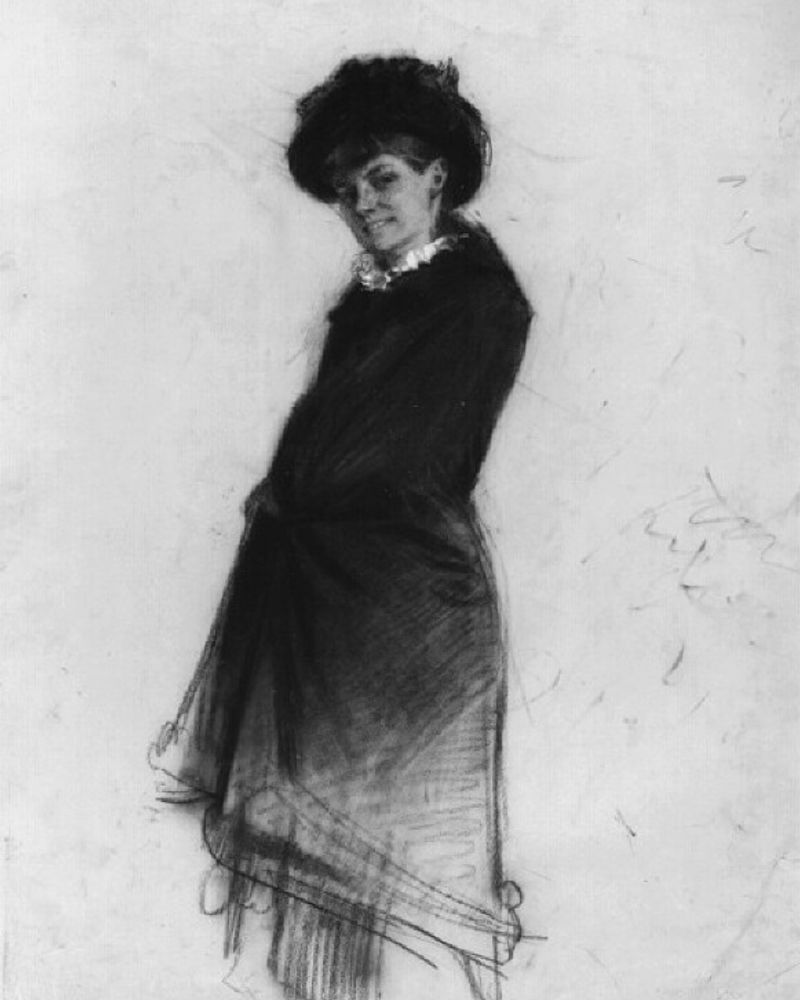Julia Beck
Julia Beck was born to wealthy parents in Stockholm. In 1873 she was accepted as a student at the Royal Swedish Academy of Fine Arts, where she was part of a pioneering group of female students that included Eva Bonnier (1857 – 1909), Karin Bergöö (married Larsson, 1859 – 1928) and Jenny Nyström (1854 – 1946). The first time Beck came to Paris was in 1878. A year later she returned and rented a studio up at Montmartre together with Hildegard Thorell (1850 – 1930), Anna Norstedt (1854 – 1936) and the Norwegian artist Harriet Backer (1845 – 1932). Kåa Wennberg writes (in Julia Beck, 2012): “It was a Madame Savingé who rented out the studio and she also hired teachers for the four female artists. In addition to Leon Bonnat and Jean-Léon Gerôme, who visited their students once a week, Jules Bastien-Lepage and Gustav Courtois also came there every month to see how their skills had developed.”
In the spring of 1881 Beck continued her studies in Paris, where she became acquainted with the Swedish artists Nils Kreuger (1858 – 1930) and Georg Arsenius (1855 – 1908), with whom she had a brief fling. The Paris trip of 1882, accompanied by, among others, Karin Bergöö and Anna Nordgren (1847 – 1916) went via Berlin, Dresden, Prague, Vienna, Graz, Venice, Verona and Munich before arriving in Paris on 26 May. Beck and Bergöö visited the prestigious Salon and studied at the Académie Colarossi.
The summer of 1882 was to be life-changing for Beck. It was this summer that she visited, the now legendary, artists' colony of Grez-sur-Loing (seven miles south of Paris, close to Fontainebleau) for the first time. It was in this area that the first generation of French plein-air painters had worked in the 1840s and 1850s. In 1882, however, the terrain was occupied by all sorts of Scandinavian painters. One of these, Georg Pauli (1855 – 1935), wrote afterwards (in The Parisian Boys, 1926):
To list all the Swedes who studied in Grez during the first half of the eighties would be almost like a catalogue of the entire generation of painters in France. […] Except Carl Larsson and yours truly: Richard Bergh, Nils Kreuger, Karl Nordström, Georg Arsenius, Ivar Nyberg, Carl Trägårdh, Oscar Cantsler; Misses Julia Beck, Gerda Rydberg, Tekla Lindeström, Karin Bergöö, Emma Löfstedt. Many others not to forget.
The long time that Julia Beck spent in Grez, and its surroundings, came to profoundly enhance her artistic development. August Strindberg (1849 – 1912), who came to visit, has described how uncompromisingly Beck approached French outdoor painting: “Julia Beck sat for several weeks in the rain and thick and even went out into the swamp by horse and cart, or stepped around in large clogs to get her grey weather mood.” Beck herself explained: “The painting must be executed entirely outdoors. Only thus can the right mood be achieved.”
In November 1882 Beck and Bergöö returned to Paris where Beck started studying for the famous Belgian painter Alfred Stevens (1823 – 1906), whose paintings were much admired in the 1882 Exposition Internationale de peinture at Galerie George Petit. It was around this time she executed her celebrated portrait of her dearly beloved friend Georg Arsenius (undated, oil on panel, 37 x 27.5 cm, Tessininstitutet, Paris/Nationalmuseum, Stockholm).
Over the next few years, Beck alternated between studies in Paris and plein-air painting in Grez. Important study trips were also undertaken to Normandy on the French Atlantic coast. September 1888 brought a decisive change, namely the definitive move to France. In the small town of Vaucresson, two miles west of Paris, she found the perfect place to paint and here she decided to settle down - she remained here for the rest of her life. Kåa Wennberg writes (in Julia Beck, 2012):
Beautifully situated in a valley surrounded by verdant hills, Vaucresson was a grateful place if, like Julia Beck, you were looking for scenic motifs. She has told in letters “how she got up early in the morning, properly dressed with forest boots, easel, paint box and umbrella to go out into nature”. From her home, she was within walking distance of the train station, from where she could easily get to Paris to meet friends and fellow artists. Or she could travel by train out to Normandy and Brittany, and there she knew what motives awaited.
At the 1889 World’s Fair in Paris, Julia Beck received great recognition for her landscape, La Mare aux Saules and she later received the prestigious Ordre national de la Légion d’honneur in 1934. The following year, Julia Beck died at the age of 81.
Copyright Firestorm Foundation
